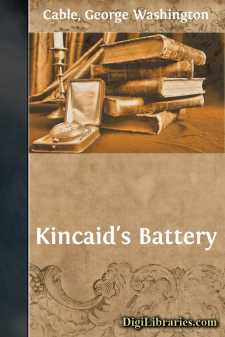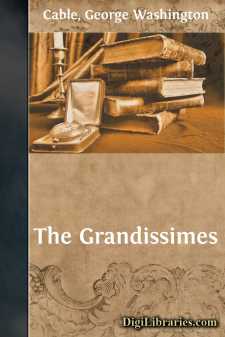Categories
- Antiques & Collectibles 13
- Architecture 36
- Art 48
- Bibles 22
- Biography & Autobiography 813
- Body, Mind & Spirit 142
- Business & Economics 28
- Children's Books 15
- Children's Fiction 12
- Computers 4
- Cooking 94
- Crafts & Hobbies 4
- Drama 346
- Education 46
- Family & Relationships 57
- Fiction 11828
- Games 19
- Gardening 17
- Health & Fitness 34
- History 1377
- House & Home 1
- Humor 147
- Juvenile Fiction 1873
- Juvenile Nonfiction 202
- Language Arts & Disciplines 88
- Law 16
- Literary Collections 686
- Literary Criticism 179
- Mathematics 13
- Medical 41
- Music 40
- Nature 179
- Non-Classifiable 1768
- Performing Arts 7
- Periodicals 1453
- Philosophy 64
- Photography 2
- Poetry 896
- Political Science 203
- Psychology 42
- Reference 154
- Religion 513
- Science 126
- Self-Help 84
- Social Science 81
- Sports & Recreation 34
- Study Aids 3
- Technology & Engineering 59
- Transportation 23
- Travel 463
- True Crime 29
George Washington Cable
George Washington Cable was an American novelist and short story writer born on October 12, 1844, in New Orleans, Louisiana. He is best known for his works depicting Creole life in Louisiana, particularly in his acclaimed novel "The Grandissimes" (1880). Cable's writings often addressed social issues such as racial equality and Southern culture, earning him both praise and criticism during his lifetime.
Author's Books:
Sort by:
CHAPTER I. The main road to wealth in New Orleans has long been Carondelet street. There you see the most alert faces; noses—it seems to one—with more and sharper edge, and eyes smaller and brighter and with less distance between them than one notices in other streets. It is there that the stock and bond brokers hurry to and fro and run together promiscuously—the cunning and the simple, the...
more...
THE STEAMBOAT LEVEE Saturday, April, 1852. There was a fervor in the sky as of an August noon, although the clocks of the city would presently strike five. Dazzling white clouds, about to show the earliest flush of the sun's decline, beamed down upon a turbid river harbor, where the water was deep so close inshore that the port's unbroken mile of steamboat wharf nowhere stretched out into the...
more...
I CARROLLTON GARDENS For the scene of this narrative please take into mind a wide quarter-circle of country, such as any of the pretty women we are to know in it might have covered on the map with her half-opened fan. Let its northernmost corner be Vicksburg, the famous, on the Mississippi. Let the easternmost be Mobile, and let the most southerly and by far the most important, that pivotal corner of...
more...
I Next morning he saw her again. He had left his very new law office, just around in Bienville Street, and had come but a few steps down Royal, when, at the next corner below, she turned into Royal, toward him, out of Conti, coming from Bourbon. The same nine-year-old negro boy was at her side, as spotless in broad white collar and blue jacket as on the morning before, and carrying the same droll air...
more...
I New Orleans, Dec. 1, 1860.—I understand it now. Keeping journals is for those who cannot, or dare not, speak out. So I shall set up a journal, being only a rather lonely young girl in a very small and hated minority. On my return here in November, after a foreign voyage and absence of many months, I found myself behind in knowledge of the political conflict, but heard the dread sounds of disunion...
more...
CHAPTER I. AN OLD HOUSE. A few steps from the St. Charles Hotel, in New Orleans, brings you to and across Canal Street, the central avenue of the city, and to that corner where the flower-women sit at the inner and outer edges of the arcaded sidewalk, and make the air sweet with their fragrant merchandise. The crowdвÐâand if it is near the time of the carnival it will be...
more...
HOW I GOT THEM. 1882-89. True stories are not often good art. The relations and experiences of real men and women rarely fall in such symmetrical order as to make an artistic whole. Until they have had such treatment as we give stone in the quarry or gems in the rough they seldom group themselves with that harmony of values and brilliant unity of interest that result when art comes in—not so much to...
more...
I RUTH AND GODFREY The old street, keeping its New England Sabbath afternoon so decently under its majestic elms, was as goodly an example of its sort as the late seventies of the century just gone could show. It lay along a north-and-south ridge, between a number of aged and unsmiling cottages, fronting on cinder sidewalks, and alternating irregularly with about as many larger homesteads that sat back...
more...
MY OWN ACRE A lifelong habit of story-telling has much to do with the production of these pages. All the more does it move me because it has always included, as perhaps it does in most story-tellers, a keen preference for true stories, stories of actual occurrence. A flower-garden trying to be beautiful is a charming instance of something which a storyteller can otherwise only dream of. For such a...
more...
CHAPTER I MASKED BATTERIES It was in the Théatre St. Philippe (they had laid a temporary floor over the parquette seats) in the city we now call New Orleans, in the month of September, and in the year 1803. Under the twinkle of numberless candles, and in a perfumed air thrilled with the wailing ecstasy of violins, the little Creole capital's proudest and best were offering up the first cool night...
more...











